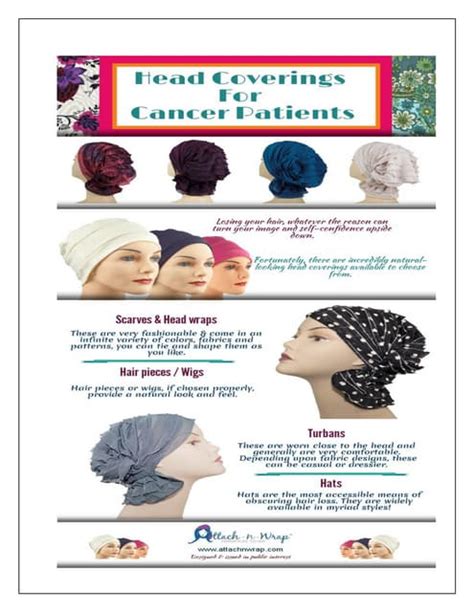Cancer treatment can have a significant impact on your hair, leading to hair loss or thinning. Head coverings offer a stylish and comfortable solution to manage hair-related challenges during and after treatment.

Choosing the Right Head Covering
With numerous options available, choosing the right head covering can be overwhelming. Consider these factors:
- Material: Natural fibers like cotton, silk, and bamboo absorb moisture and provide breathability. Synthetic materials offer durability and can be easier to care for.
- Style: From scarves to hats, there’s a wide range of styles to complement your taste and lifestyle.
- Comfort: Choose a head covering that fits comfortably and doesn’t irritate your scalp.
- Coverage: Determine the level of coverage you need, whether partial, full, or customizable.
Types of Head Coverings
1. Scarves: Versatile and adjustable, scarves can be draped in multiple ways to create various looks.
2. Hats: Offer full coverage and can be accessorized for style.
3. Beanie Caps: Comfortable and casual, beanies provide warmth and coverage.
4. Headbands: Ideal for light coverage or to accentuate a hairstyle.
5. Turbans: Elegantly designed to provide full coverage and enhance style.
Benefits of Head Coverings
- Emotional Support: Head coverings can boost confidence and reduce self-consciousness about hair loss.
- Sun Protection: Protect your scalp from harmful UV rays.
- Warmth: Provide warmth during cold weather.
- Privacy and Dignity: Offer a sense of privacy and dignity during treatment.
- Style: Enhance your appearance and make you feel more like yourself.
Common Mistakes to Avoid
- Choosing the Wrong Material: Synthetic materials can trap moisture and irritate the scalp.
- Overtightening: Avoid head coverings that are too tight, as they can cause discomfort and headaches.
- Neglecting Hygiene: Regularly wash and maintain your head coverings to prevent bacteria buildup.
- Ignoring Comfort: Don’t prioritize style over comfort. Choose a head covering that doesn’t rub or cause discomfort.
- Feeling Embarrassed: Remember that wearing a head covering is normal and helps you feel more comfortable and confident.
How to Choose a Head Covering
- Consider Your Needs: Determine the functions and features you need in a head covering.
- Research and Explore: Explore different materials, styles, and brands to find the best fit.
- Consult a Healthcare Professional: Discuss your needs with your doctor or nurse for recommendations and support.
- Try Before You Buy: Sample different head coverings to ensure comfort and coverage before purchasing.
- Seek Inspiration: Find inspiration from online communities, fashion magazines, or support groups for ideas.
Table 1: Head Covering Materials and Their Properties
| Material | Properties |
|---|---|
| Cotton | Breathable, moisture-wicking, soft |
| Silk | Luxurious, smooth, hypoallergenic |
| Bamboo | Anti-bacterial, eco-friendly, durable |
| Polyester | Durable, moisture-resistant, wrinkle-free |
| Nylon | Lightweight, stretchy, fast-drying |
Table 2: Types of Head Coverings and Their Coverage
| Type | Coverage |
|---|---|
| Scarves | Partial to full |
| Hats | Full |
| Beanie Caps | Full |
| Headbands | Partial |
| Turbans | Full |
Table 3: Benefits of Head Coverings for Cancer Patients
| Benefit | Description |
|---|---|
| Emotional Support | Boost confidence, reduce self-consciousness |
| Sun Protection | Protect scalp from UV rays |
| Warmth | Provide warmth during cold weather |
| Privacy and Dignity | Offer privacy and dignity during treatment |
| Style | Enhance appearance, make you feel more like yourself |
Table 4: Common Mistakes to Avoid When Choosing Head Coverings
| Mistake | Description |
|---|---|
| Choosing the Wrong Material | Synthetic materials can trap moisture and irritate the scalp |
| Overtightening | Cause discomfort and headaches |
| Neglecting Hygiene | Bacteria buildup can occur |
| Ignoring Comfort | Prioritize style over comfort |
| Feeling Embarrassed | Wearing a head covering is normal and comfortable |
